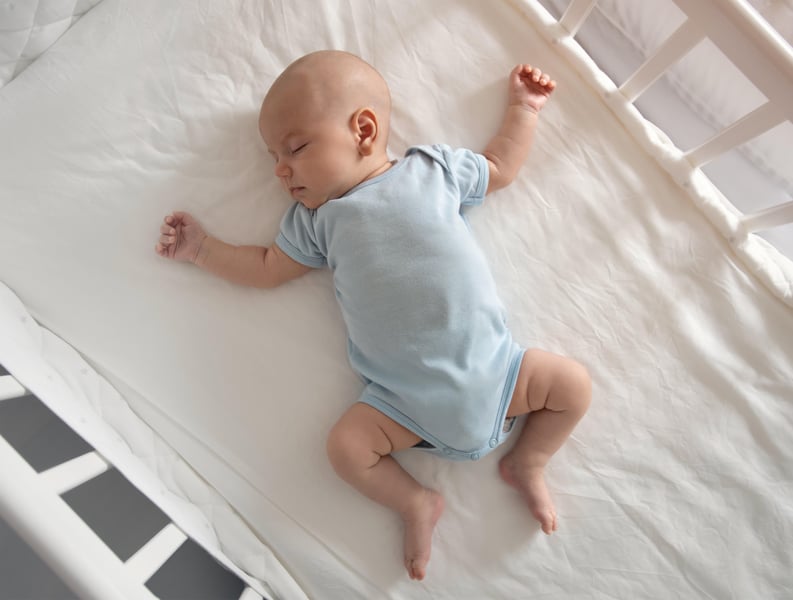Manténgase sano!

- Amy Norton
- Posted May 25, 2023
Research Helps Uncover Causes of SIDS
Researchers have found another clue as to why some infants die suddenly in their sleep, and it's related to a faulty chemical receptor in the brainstem.
Experts said the findings provide another puzzle piece in understanding the root causes of sudden infant death syndrome (SIDS).
By examining autopsied brain tissue, researchers found that a particular chemical receptor was altered in the brain stems of babies who'd died of SIDS, versus infants who'd died of other causes.
The receptor, called serotonin 2A/C, is believed to play a key role in helping a sleeping infant wake up and gasp for air in response to oxygen deprivation.
"This 2A receptor is very important in arousing them as a defense mechanism," said Robin Haynes, a researcher at Boston Children's Hospital who led the study.
She stressed that the underlying biology of SIDS is complex, and no one is saying an abnormal serotonin receptor is the single culprit. It's thought, Haynes said, that there are multiple mechanisms at work, and they may vary from one infant to another.
But for at least some infants who succumb to SIDS, dysfunction in this particular brain receptor may be a reason, she noted.
"This study is giving us one more piece of information about the intrinsic vulnerability to SIDS," Haynes said.
Many people may know SIDS is related to sleeping position and environment -- including the fact that tummy sleeping can raise an infant's risk.
In 1992, the American Academy of Pediatrics began advising parents to put their babies to sleep on the back, not the tummy. The federal government, meanwhile, launched a "Back to Sleep" campaign to raise public awareness, and by 1998, the national rate of SIDS had dropped by 45%.
However, that decline stalled out. All told, about 3,400 infants die suddenly each year in the United States, including roughly 1,400 who die from SIDS, according to the U.S. Centers for Disease Control and Prevention. Many of the other deaths are caused by accidental suffocation or strangulation during sleep.
So over the years, experts have been advising additional safe-sleep measures -- like putting babies to sleep only in a crib or bassinet with a flat, firm mattress, and keeping the area free of soft bedding, toys and crib bumper pads. Parents should also have their baby sleep in their room, but not in their bed.
But SIDS involves more than environmental factors, Haynes said.
There have to be underlying biological reasons that certain infants are vulnerable -- characteristics that make them unable to respond normally when an environmental stressor, like tummy-sleeping, impairs their breathing.
The new study, published May 25 in the Journal of Neuropathology & Experimental Neurology, is the first to look at whether the serotonin 2A/C receptor may be one of those reasons.
Haynes and her colleagues studied tissue collected from the San Diego Medical Examiner's Office, related to the deaths of 70 infants. SIDS was the cause in 58 cases, while 12 infants died of other causes.
The researchers found that the serotonin receptor was altered in the brain stems of infants who'd died of SIDS.
Gail Bagwell is a clinical nurse specialist in neonatology at Nationwide Children's Hospital, in Columbus, Ohio. She said there is a critical period in infant development when SIDS occurs -- usually between 2 and 4 months of age, but up to 6 months.
It's thought that biological vulnerability and environmental stressors, such as sharing a bed, coming together during that period can lead to SIDS.
As for the underlying biology, Bagwell agreed there will likely be no single culprit. She noted that one recent study, for example, found that blood samples from infants who'd died of SIDS showed decreased activity in an enzyme called butyrylcholinesterase, versus infants who'd died of other causes.
That enzyme plays a key role in producing a chemical along the brain's "arousal" pathway.
Yet another recent study, of siblings of infants who died of SIDS, suggested that genetics puts some babies at increased risk: Those siblings' own risk of SIDS was fourfold higher than average.
How all these different findings might fit together, Bagwell said, is unknown for now.
Haynes made a similar point. "We're putting together the pieces of the puzzle incrementally," she said.
But while only some infants may have underlying vulnerabilities to SIDS, it's critical that all parents and caregivers follow safe-sleeping practices, both experts said.
For one, those steps protect infants from accidental suffocation and strangulation, too. For another, there is no way of identifying which infants are particularly vulnerable to SIDS.
That might change in the future. Haynes said one of the ultimate goals is to figure out whether there is a "biomarker" -- something that can be easily measured in the blood, for example -- that shows whether a newborn is at increased risk of SIDS.
More information
The American Academy of Pediatrics has advice on safe sleep for infants.
SOURCES: Robin Haynes, PhD, principal associate, pathology, Boston Children's Hospital, Harvard Medical School, Boston; Gail Bagwell, DNP, APRN, CNS, division of neonatology, Nationwide Children's Hospital, Columbus, Ohio; Journal of Neuropathology & Experimental Neurology, May 25, 2023, online
